Mobile advertising trends are shaping the way businesses connect with their audiences. With people spending an average of 4.65 hours daily on their phones, mobile marketing has become essential for reaching consumers effectively. To survive in the competitive marketplace, you must keep up with the most recent developments in mobile advertising.
This article explores 11 critical mobile advertising trends businesses should consider. These trends can help you more successfully target your audience and optimize your marketing efforts.
What Is Mobile Advertising?
Mobile advertising refers to promotional activities that target users on their mobile devices, including smartphones and tablets. These ads can appear within mobile apps, websites, social media platforms, or via SMS messages. They aim to capture users’ attention while they’re engaged with their devices.
For example, a company might promote its latest product through banner ads within a mobile game. Alternatively, it might utilize location-based targeting to display ads for nearby stores or services when users browse their smartphones.
According to Statista, mobile advertising spending reached $327 billion worldwide in 2022 and is projected to surpass $400 billion by 2024. This rapid growth underscores the significance of mobile advertising in today’s marketing field.
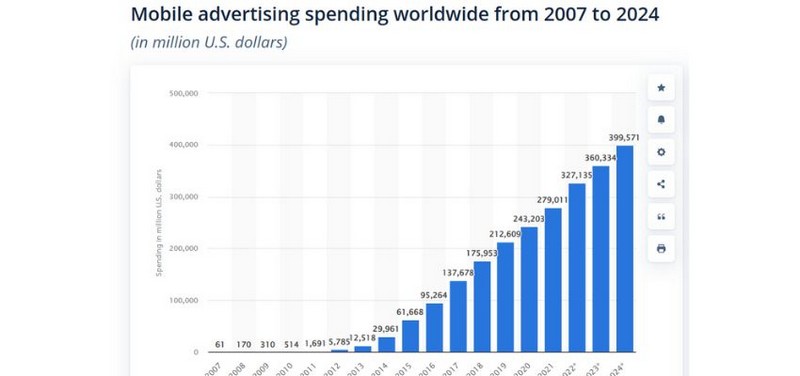
Why is Mobile Advertising Important?
Mobile advertising is essential for several reasons, mainly because many people use smartphones and other mobile gadgets. Here’s why mobile advertising matters:
| Reach | As more people use smartphones worldwide, mobile ads can reach many people. They let advertisers reach their desired audience wherever they are, whether at home, work, or out and about. |
| Targeting | Mobile advertising platforms provide advanced targeting features that consider where people are, their ages and interests, and what they usually browse online. This helps advertisers customize their messages to reach the right people, making their ads more effective. |
| Engagement | Mobile devices are highly personal and often used for social networking, shopping, and entertainment. This allows advertisers to engage with users more intimately and interactively through mobile ads. |
| Cost-effectiveness | Advertising on mobile devices can be cheaper and reach more people than advertising on TV or in newspapers. Advertisers can get a lot of people at a low cost, mainly through ads in apps or on websites that work well on phones. |
| Measurable results | Mobile advertising platforms give advertisers detailed data and statistics to see how well their ads are performing immediately. This information helps them improve their advertising plans and get more out of their investment. |
Let’s consider an example of a local coffee shop that wants to increase foot traffic to its newly opened branch. The shop can launch a mobile advertising campaign targeting users within a specific radius of the store’s location.
The coffee shop can display ads promoting special discounts or offers to users near the store by applying location-based targeting. These ads may appear on various mobile platforms, such as social media apps, gaming apps, or mobile websites.
When users see the ad and are enticed by the offer, they’re more likely to visit the coffee shop, resulting in increased sales and brand awareness.
Top 10 Mobile Advertising Trends in 2024 You Need To Know
- Mobile-First And User-First Display Ads
With technological development, many advertisers aim to get users to spend their time on their information on different devices.
Therefore, mobile-first and user-first display ads are applied to engage users’ interaction because they give mobile users the first chance to see marketing visuals and meanings.
For example, when surfing social media feeds, you can see an ad that appears on the screen and boasts a clear call to action easily with your thumb.
Many companies today are increasingly prioritizing mobile versions of their web pages because of the popularity of mobile devices and online shopping among consumers.
For example, Domino’s increased mobile orders by 40% by focusing on a user-friendly interface. Spotify has 242 million monthly active users as of Q4 2023 by prioritizing personalized recommendations within their mobile app.
According to Statista’s data, the use of mobile phones increased rapidly each year worldwide, from more than 680 million units (2012) to nearly 1340 million units in 2023.

Key takeaways:
- Mobile advertising spending has surpassed $327.1 billion worldwide and is projected to reach 339 billion by 2023.
- 97.6% of internet users aged 16-24 own a smartphone and 92.3% use social media.
- In Q2, 2024, advertisers will spend more than £3000 million on online display advertising.

There are numerous ways advertisers can embrace this trend:
- High-performing designs: prioritize mobile-friendly ad formats, then scale up for desktop browsers.
- Less text, more images: When applying mobile-first ads, remember the minimal text, larger font size, and simple functionality.
- The first three seconds: Advertisers should create messages that consumers can quickly understand.
- Rich Multimedia Effects In Mobile Ads
Rich media formats have become one of the most effective ways of marketing mobile apps to drive engagement rates.
Rich multimedia includes words, pictures, sound, moving images, and videos. It’s set up like a chain of connected parts that users can click on to find out more or to play a small game in the ad.
For instance, someone using their phone to look at a website might engage with an ad by tapping on an image banner.
Multimedia in mobile ads, including pretty pictures, video, and moving images, gives brands more creativity and engagement with full-screen ad units.

Adidas launched a mobile marketing campaign in 2013 using video and banner ads, resulting in a 20% conversion rate from mobile stores.
Burger King used AR to create a mobile marketing campaign in Brazil (2019), reaching 17 million people and increasing app downloads by 60%.
Key takeaways:
- In 2022, users spent an average of 5 hours on their mobile phones daily.
- Almost 60% of website traffic in 2023 is portable.
- In its latest in-app advertising research, Statista estimates in-app advertising to hit 462.30 billion in 2027.
- By 2024, In-App Advertising is expected to generate an average of US$53.96 in revenue from ads per mobile internet user.
- By 2032, the mobile marketing market will reach $91 billion, growing at a 17.8% CAGR. (Persistence Market Research).

Companies can use rich multimedia in three main ways to their advantage:
- Interactive Storytelling: Attract users with micro-videos, GIFs, or playable ads that tell stories within seconds.
- Gamification: Incorporate interactive elements like quizzes, polls, or mini-games to drive user engagement and brand recall.
- Personalization: the ad experience is based on user preferences and data, making it relevant and engaging.
- Gamification To Become Mainstream
Mobile games have changed the gaming world and introduced many new games. Many apps now have fun game features because companies see how games can motivate people.
Gamification means using game stuff in things that aren’t games to encourage folks.
For example, Duolingo creates points, streaks, and leaderboards to turn language learning into a game. This approach has motivated more than 500 million learners to know more than 40 languages since 2011.

The Gamification Market size is estimated at USD 15.43 billion in 2024 and is expected to reach USD 48.72 billion by 2029.
Key takeaways:
- Gamification also helps with customer retention, increasing customer retention rates by 5% and profits by 25% to 95%.
- It is projected that the global gamification market would grow from $9.1 billion in 2020 to $30.7 billion by 2025.
- 87% of businesses will utilize gamified techniques in the next five years, starting in 2019.
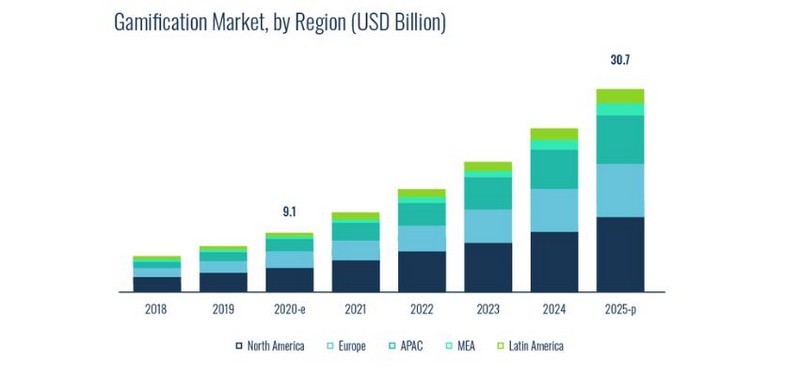
Companies can apply gamification by creating a game that increases brand awareness, educates users about your solution, boosts your website performance, and promotes inbound leads.
For example, a company in the fitness industry could develop a mobile game where players engage in virtual workouts, earning points for completing challenges and progressing through levels.
The game educates users while promoting the brand by incorporating elements of the company’s fitness solutions, such as specific exercises or nutritional tips. Players could unlock exclusive content or discounts through integrations with the company’s website, driving traffic and boosting website performance.
- 5G Optimization
Several companies are leading the way in 5G optimization, including telecommunications providers, technology companies, and equipment manufacturers. For example, companies like Verizon, AT&T, and T-Mobile are investing heavily in upgrading their networks to 5G.
Additionally, technology giants such as Qualcomm, Huawei, and Ericsson are developing advanced technologies and solutions to enhance the efficiency and capabilities of 5G networks.
The increasing demand for high-speed connectivity drives 5G optimization trends to emerge. According to Ericsson, there will likely be 3.5 billion 5G subscriptions by 2025, or around 40% of all mobile subscriptions worldwide.
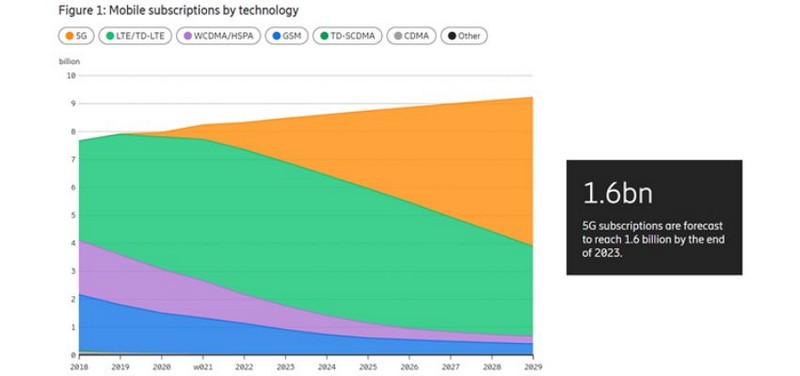
Additionally, Cisco predicts that global mobile data traffic will increase nearly sevenfold between 2021 and 2026, with 5G networks playing a significant role in this growth.
Key takeaway
- With a predicted valuation of USD 84.31 billion in 2023, the global market for 5G services is projected to increase at a CAGR of 59.4% between 2023 and 2030.
- The revenue generated by service providers and the penetration of 5G subscriptions positively correlates in the top 20 5G markets.
To effectively apply 5G optimization for businesses, consider the following strategies:
- Collaborate with network providers: Partner with telecommunications providers to leverage their expertise and resources in optimizing 5G network performance for your business needs.
- Invest in infrastructure: Upgrade your network infrastructure to support 5G connectivity, including deploying advanced equipment and technologies to maximize performance and reliability.
- Embrace innovative use cases: Explore new opportunities for leveraging 5G technology to enhance business operations, improve customer experiences, and drive innovation.
- M-Commerce Is The New Normal
This is the best time for business owners to set goals and explore opportunities to expand market reach.
Mobile commerce (M-commerce) involves using smartphones and tablets to shop, go to the bank, and pay.
Because people are busy and want things to be easy use their phones to shop.
For example, Starbucks’s mobile app allows users to order and pay for drinks in advance, helping to raise the company’s global revenues to $32.3 billion in 2022. Amazon also offers a user-friendly app with fast browsing and payment options for online shopping.
It’s predicted that sales from mobile commerce will hit $4.5 trillion by 2024, making up almost 70% of all online retail sales.
Key takeaways:
- According to Zebra’s 16th annual global shopper study, 87% of millennials, 84% of Gen Zers, and 84% of baby boomers use mobile ordering.
- According to Statista, the Asia-Pacific region has 72.9% of retail e-commerce sales from mobile devices.
- In 2024, global e-commerce sales are expected to reach $6.4 trillion.
- Mobile commerce sales will increase by 25.5% annually from 2019 to reach $488.0 billion in 2024, accounting for 44% of all online sales.
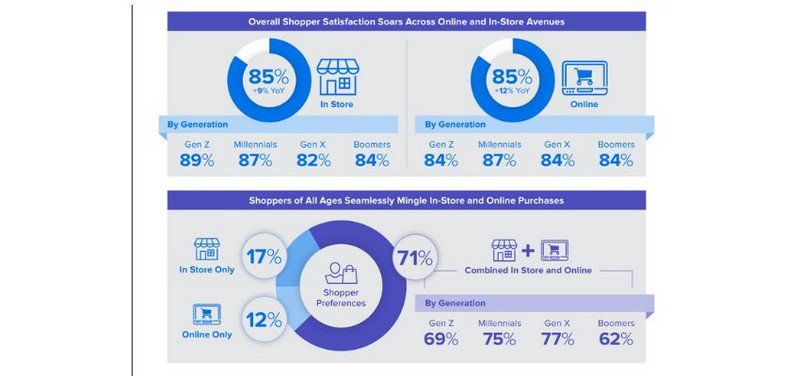
There are three ways for companies to apply M-commerce:
- Develop a mobile-friendly website or app: Make sure your online shop works well on phones and tablets so customers can easily use it.
- Leverage social media marketing: Utilize platforms like Instagram and TikTok to showcase products and drive consumers towards your mobile store.
- Offer exclusive mobile deals and promotions: Encourage users with special offers and discounts when they buy products through your app or mobile website.
- Visual Search Growth
Various platforms are changing the search landscape with the development of technology.
Image recognition and machine learning technologies allow platforms to understand and accurately respond to users’ visual requirements.
With the popularity of smartphone cameras, growth in e-commerce, and rising demand for visual content, many applications use visual search technology to assist their users in finding what they want quickly and accurately.
For example, Google applied visual search technology – Google Lens, into their app to help users search for objects to gain more information. 32.5% of 65,388 Google Lens search results have a “matching” keyword in the page’s title tag. In 2023, Google Lens is now used for 10 billion visual searches per month (Data Dive)
Key takeaways:
- The market for visual search is projected to grow from its 2023 valuation of $8.5 billion to $58 billion by 2031.
- Images are returned for 19% of search queries on Google.
- A survey by Slyce found that 74% of consumers use visual search to research or buy products online.
Companies can leverage visual search to improve how customers find products. Instead of typing descriptions, customers can simply upload a picture of an item (like a shirt they saw in a magazine), and the search engine will identify comparable goods offered for sale.

- Augmented Reality Shopping
Augmented Reality (AR) shopping is a tech that overlays digital content, such as pictures, videos, or 3D objects, on top of what you see in real life to enhance the shopping experience. It enables consumers to see how products would look or fit in their homes or on their bodies before buying them.
According to Grand View Research, the global AR market reached $57.26 billion in 2023. Another study found that interacting with AR-enabled products increases the purchase conversion rate by 94%.
AR shopping apps and platforms have gained popularity, with companies like IKEA, Sephora, and Warby Parker implementing AR features into their apps. For instance, IKEA Place lets users preview furniture in their homes using AR technology, while Sephora Virtual Artist allows customers to try makeup virtually.
According to a report by NielsenIQ, 61% of consumers prefer stores that offer AR experiences. A survey by Deloitte showed that customers are 40% more likely to spend more for a product if they can use augmented reality to experience it.
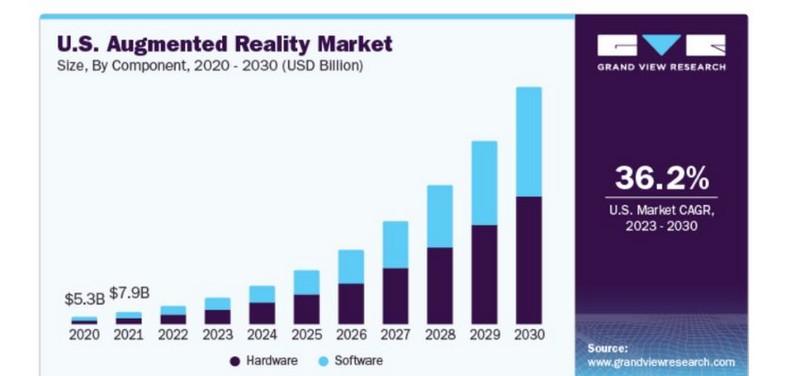
Key Takeaway
- The adoption of AR shopping is increasing rapidly, with many retailers and brands integrating AR technology into their online and offline sales channels.
- According to Zion Market Research, the worldwide augmented reality market was worth about $17.14 billion in 2020. Experts predict it will hit about $128 billion by 2028, growing 29% yearly.
- After seeing the products through augmented reality, 80% of online customers felt more secure about their purchases.
To apply augmented reality shopping, businesses can create mobile apps or website features that allow customers to visualize products in their own space. Make the AR experience user-friendly and seamless, ensuring customers can easily interact with the virtual products.

- Live Video Content
Live video content has become increasingly popular due to its ability to create authentic and engaging audience interactions. Platforms such as Facebook, Instagram, YouTube, and Twitch have incorporated live streaming features, and many businesses are leveraging live video to connect with their audience more directly and personally.
According to a Livestream and New York Magazine report, 80% of audiences would watch a brand’s live video rather than read a blog. Additionally, Facebook’s surveys showed that people watch live videos three times as long as they do pre-recorded ones.
Xbox Series X – World Premiere – 4K Trailer
Microsoft additionally broadcasts product launches live.
Furthermore, the increasing popularity of platforms like TikTok and Snapchat has led to a rise in short-form live videos catering to younger audiences’ preferences.
The global live-streaming market expanded from $1.24 billion in 2022 to $1.49 billion in 2023, with a CAGR of 20.6%. With a 21.2% compound annual growth rate, it is projected to reach $3.21 billion in 2027.
Key takeaways
- 50% of TikTok viewers have purchased it after viewing TikTok LIVE content.
- 28% of marketers believe live video content offers the best ROI (Return on Investment).
- A third of the audience has watched a live video broadcast at least once a week.
Here are some key strategies backed by data to maximize the impact of your live streams:
- Targeted content: Tailor your live content to address specific audience segments and their needs. Highlight product features relevant to their pain points or conduct industry-specific Q&A sessions.
- Interactive engagement: Host live polls to gauge audience interest, conduct live product demonstrations with on-screen annotations, and encourage viewers to submit questions in real time.
- Strategic Partnerships: Partner with influencers or industry experts to tap into new audiences and gain fresh perspectives.
- User-Generated Content
Unlike content created by brands or professional content creators, UGC is generated by consumers or audiences who voluntarily contribute their material. This content can be found on various social media platforms, forums, review websites, and other online communities.
UGC stands out for its authenticity and relatability. Because it is created by real users rather than brands or advertisers, UGC often resonates more with audiences and is perceived as more genuine.
90% of customers feel authenticity matters when choosing which businesses to enjoy and support, according to a Stackla poll.
Research by Bazaarvoice found that 51% of Americans consider user-generated content (UGC) on a company’s website more than other content.
Several companies have effectively leveraged UGC as part of their marketing strategies. For example, clothing retailer ASOS encourages customers to share photos of themselves wearing ASOS clothing using the hashtag #AsSeenOnMe.
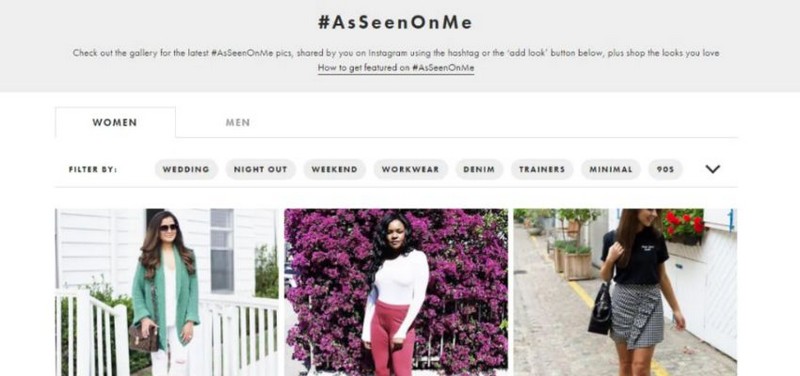
Similarly, GoPro has built its entire brand around UGC, with users sharing action-packed videos and photos captured with GoPro cameras.
As more people share their experiences, opinions, and creations online, certain types of content may gain popularity and become trends.
Key Takeaways:
- According to Forbes, compared to standard commercials, UGC-based ads have a 50% lower cost per click and 4 times greater click-through rates.
- According to Nielsen, consumers are 92% more likely to trust peer recommendations over traditional advertising.
- According to research by SEMrush, 86% of businesses use UGC as a valuable part of their marketing strategy, citing its effectiveness in driving engagement and conversions.
To effectively apply user-generated content for businesses, consider the following strategies:
- Encourage and incentivize participation: Offer incentives such as discounts, giveaways, or recognition for users who contribute to UGC, encouraging them to engage with your brand.
- Monitor and moderate content: Make sure UGC reflects any possible problems or concerns and is consistent with your brand’s values and rules by monitoring and moderating it regularly.
- Amplify and showcase UGC: Your website, social media accounts, and other marketing materials should prominently display user-generated content to highlight actual consumer experiences and foster audience trust.
- AI Integrations And Innovations
AI integrations and innovations include incorporating artificial intelligence (AI) technologies into various products, services, and business processes to enhance functionality, efficiency, and user experience.
Many companies have effectively leveraged AI integrations and innovations to streamline operations, improve decision-making, and deliver enhanced customer experiences.
For instance, e-commerce giant Amazon utilizes AI algorithms for product recommendations, inventory management, and logistics optimization, increasing sales and customer satisfaction. Similarly, financial institutions like JPMorgan Chase use AI-powered algorithms for fraud detection and risk assessment.
The emergence of AI trends is driven by several factors, including advancements in AI technology, growing demand for automation and efficiency, and increasing data availability.
In 2022, the worldwide artificial intelligence (AI) market was estimated at USD 454.12 billion. It is anticipated to grow at a 19% CAGR from 2023 to 2032, reaching over USD 2,575.16 billion.

AI is widely used in various areas, including healthcare, retail, banking, and manufacturing, driving its fast expansion.
Key Takeaways
- According to McKinsey, AI-driven automation could increase global productivity by up to 3.5% annually.
- According to a PwC survey, 84% of CEOs believe AI will significantly impact their organization’s decision-making.
- By 2027, AI-powered fraud detection is predicted by Juniper Research to save organizations $10 billion a year.
To apply AI effectively for businesses, consider the following strategies:
- Identify use cases: Assess your business processes and areas where AI technologies can add value, such as customer service, marketing, operations, or product development.
- Invest in talent and infrastructure: Build a team of skilled professionals with expertise in AI technologies, data science, and machine learning, and invest in the infrastructure and tools needed to support AI initiatives.
- Continuously evaluate and iterate: Monitor the performance of AI integrations, gather user feedback, and iterate on solutions to improve accuracy, efficiency, and user satisfaction.
- Location-Based Advertising
Location-based advertising is a marketing strategy that utilizes consumers’ geographical locations to deliver targeted advertisements. This kind of advertising uses technologies like Wi-Fi and GPS to pinpoint the position of mobile device users. It displays appropriate advertisements based on their closeness to specific physical sites or areas of interest.
Numerous companies have successfully implemented location-based advertising strategies to engage their target audience effectively. For instance, mobile apps like Grab and Lyft utilize location data to connect users with nearby drivers, providing a seamless and convenient transportation experience.
Retail giants like Walmart and Target use location-based advertising to send targeted promotions and offers to shoppers near their stores, driving both online and offline sales.
According to Statista, smartphone users worldwide are projected to reach 7.49 billion by 2025. This widespread use of mobile devices has made location-based advertising a prominent marketing strategy for businesses looking to get consumers on the go.
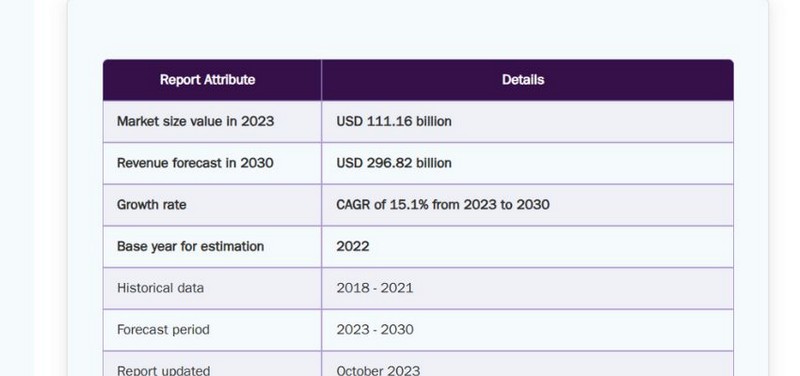
Key takeaways
- Location-based advertising is a rapidly expanding sector. Its projected market size is $296.82 billion by 2030, representing a CAGR of 15.1% from 2023 to 2030.
- According to xAd’s “Mobile Path to Purchase” study, 44% of consumers say their mobile devices—smartphones or tablets—are the most essential tool in helping them purchase.
To apply location-based advertising effectively for businesses, consider the following strategies:
- Recognize your target audience: To produce more relevant and targeted advertisements, use data analytics tools to discover more about the behavior, interests, and demographics of your target audience.
- Use geotargeting: Implement geotargeting techniques to deliver ads to consumers based on their real-time location, ensuring that your messages reach the right people at the right time.
- Measure and optimize: Monitor critical metrics for your location-based advertising campaigns, such as click-through rates, conversion rates, and return on investment, and adjust your strategy based on the data.
Conclusion
Mobile advertising trends continue to shape the digital landscape, offering businesses vast opportunities to reach their target audiences. Mobile ads have become indispensable for effective marketing strategies with the increasing usage of smartphones worldwide.
From video ads to interactive content, businesses leverage various formats to engage users on their mobile devices. As we move forward, staying updated with emerging technologies and consumer preferences will be crucial for maximizing the impact of mobile advertising campaigns.
Frequent Ask Question
What Is The Latest Advertising Trend?
The latest advertising trend is to use remarkable technologies like virtual reality (VR) or augmented reality (AR) to provide customers with dynamic and captivating brand experiences.
What Does Mobile App Advertising Hold For The Future?
Mobile app advertising is expected to continue growing in importance, fueled by advancements in technology such as artificial intelligence (AI), machine learning, and increased personalization. It will offer users more targeted and relevant ads, leading to higher conversion rates.
What Kind Of Mobile Advertising Is The Most Widely Used?
Currently, display and in-app advertising are among the most widely used forms of mobile advertising. These include banner ads, interstitial ads, native ads, and rewarded ads integrated within mobile apps.
Why Is Mobile Marketing Growing In Popularity?
Due to the increasing use of smartphones and the length of time users spend on them, mobile marketing is becoming more popular. It allows advertisers to reach consumers in real time, target specific demographics, and measure the effectiveness of their campaigns with greater accuracy.
Which Kinds Of Issues Do You Anticipate Coming Up With Mobile Advertising?
Some potential issues with mobile advertising include privacy concerns related to data collection and tracking. There is also the problem of ad fraud and ad blocking by users. Additionally, there’s the challenge of creating ads that are not intrusive or disruptive to the user experience.
What Dangers Come With Using Mobile Marketing?
Mobile marketing carries risks, such as potential data breaches and infringement of user privacy. There’s also the risk of backlash from intrusive or irrelevant ads and reliance on third-party platforms or technologies.
These platforms may change their policies or algorithms, impacting the effectiveness of marketing campaigns. Advertisers must navigate these risks carefully and prioritize user trust and data security.






